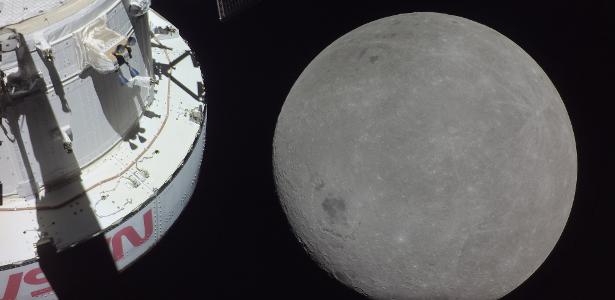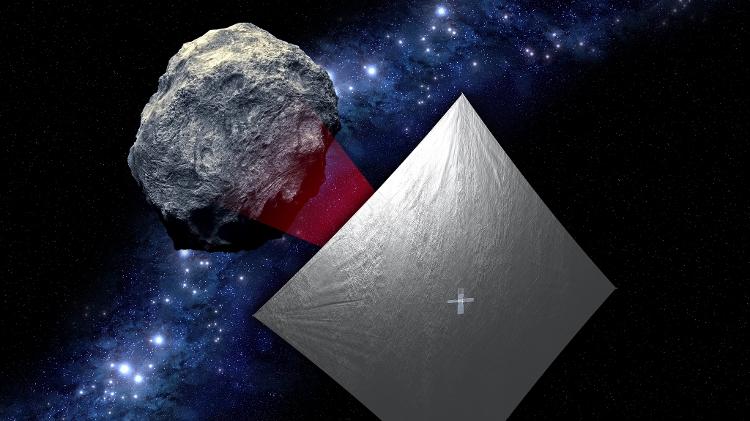Ten ‘CubeSats’ harnessed an SLS rocket (space release System or the Space Launch System), which launched the Orion capsule into lunar orbit on a spaceflight. They are tiny satellites, about the size of a shoebox, that will conduct various scientific experiments.
It is a 6U – a U equal to a 10 cm cube at the edge – 20 cm high, 10 cm wide and 34 cm long. Each weighs between 1 and 10 kilograms.
CubeSats is developed by NASA, through space agencies, universities, small and large space companies and/or research institutes. Its goals include studies of various aspects of the moon and solar system, and new technologies for interplanetary travel.
Check out the post for the 10 nanosatellites launched with the Artemis 1 mission:
ArgoMoon
It was developed by the Italian company Argotec, for the Italian Space Agency, and its goal is to record interim stage images of cryogenic propulsion (ICPS) from an SLS rocket and later from Earth and the Moon. This information will be useful for planning future missions. Equipped with two high-definition cameras and advanced imaging software, it really works and sends us beautiful pictures of the moon.
BioSentinel
It aims to measure the impact of space radiation on living organisms beyond Earth’s protective magnetosphere. For this, they carry yeast cells – which have mechanisms similar to those of humans. It will be the first long-term biological experiment to take place in deep space, and it could help protect astronauts on distant missions, such as future Mars exploration.
CuSP
The CubeSat Solar Particle Study (CuSP) will study the radiation and magnetic fields that stream from the Sun – and can cause various effects on Earth. It was developed jointly by the Southwest Research Institute in partnership with NASA. Equipped with three instruments, it will orbit the Sun, and could be the first step toward creating a constellation of nanosatellites to continuously monitor space weather.
eculius
Developed by the University of Tokyo and the Japan Aerospace Exploration Agency (JAXA), it aims to measure the atmosphere around Earth – a region of our atmosphere that contains electrons and highly ionized particles orbiting with the planet. It will also study the impacts of meteorites and the dust environment around the moon. The data will be important for protecting humans and electronics from radiation damage during longer space travel.
lunar
Using an advanced infrared sensor, it will collect images and data about the lunar surface and its environment, including composition, heat signatures, the presence of water, and potential landing sites. It was funded by NASA and built by Lockheed Martin. This lunar mapping is intended to protect astronauts from potential dangers on future space missions.
moon ice cube
As the name suggests, its main mission is to examine lunar ice. It will also study the exosphere, the uppermost layer of the atmosphere, in order to understand the dynamics of water and other materials on the moon. The information provided will help predict seasonal changes in lunar ice that could affect its use as a resource in the future. It is a collaboration between the university more conditiona Busk a company And NASA.
LunaH-Map
Its name means “polar hydrogen lunar chart”. Developed by Arizona State University and sponsored by NASA, its mission is to measure the distribution and amount of hydrogen in the lunar south pole. It will produce a high-resolution map to reveal new details about potential ice distribution that have already been identified by previous missions – such as the crater. Shackleton🇧🇷 This will help us understand how the water got there, how much water might still be available, and how it might be used as a resource for longer exploration missions to the moon.
NEA Scouts
The “Near-Earth Asteroid Hunter” is a small robotic reconnaissance mission, which will fly to the 2020 GE object and send us data (size, shape, rotation, surface properties, etc.). It is equipped with a solar sail – a propulsion system that uses the sun’s radiation pressure – and a camera. Flag 20 megapixelsa nyakam🇧🇷 The data can help explain how asteroids form and evolve, as well as contribute to planetary defense research. Developed by NASA.
Omotenashi
The small probe, which will detach from the nanosatellite, will be the only part of the Artemis 1 mission that will touch the lunar surface. Developed by JAXA, T.;In order to test technologies and trajectory maneuvers that allow landing small modules on moons and planets. If successful, it will also measure surface radiation and check soil-rock mechanics with accelerometers.
Team miles
Developed by Miles Space, in partnership with software developer Fluid & Reason, it intends to feature hybrid plasma and laser propellants to travel about 96 million km – being the first spacecraft of this size to reach that distance (for comparison purposes the distance from Earth to Mars is about 54 million km). . He will also test a radio program for calling. But the bigger goal is to participate in NASA’s Deep Space Race.
Some CubeSats could be having problems. To date, six of them have sent consistent signals to mission operators: Equuleus, LunIR, CuSP, LunaH-Map, ArgoMoon, and BioSentinel; Two more are running, but with anomalies: LunIR and Omotenashi; and two others (NEAScout and Team Miles) are still unable to communicate with Earth.

“Incurable thinker. Food aficionado. Subtly charming alcohol scholar. Pop culture advocate.”







More Stories
NASA Releases Selfie of Perseverance Rover Working on Mars
NVIDIA driver includes hidden Final Fantasy XVI profile
PlayStation Plus Extra and Premium saw a significant drop in players in July